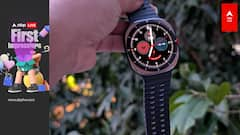Redmi Pad: A Budget-Friendly Tablet That Impresses In More Ways Than One
Redmi Pad could very well do for the budget tablet segment what Redmi Note 3 did for pocket-friendly smartphones.

With affordable prices come dated processors, odd designs, and inconsistent performance — this has pretty much been the mantra in the budget tablet market in India. Unlike in the first tablet revolution (2011-2014), when you could get excellent tablets for a surprisingly affordable price (the Google Nexus tablet was available for under Rs 20,000), the return of the tablet to the tech center stage in India in the pandemic era has been marked by tablets whose performance and design tend to vary directly with their price.
All the good tablets seemed to have migrated north of the Rs 20,000 price point, and the further north they went, the more they had to tangle with the tablet that started it all — the iPad, which has miraculously managed to stay around the Rs 30,000 price point since its arrival in India a decade ago.
This is why we must confess to being very pleasantly surprised with the Redmi Pad, which was launched a few days ago by Xiaomi in India. Xiaomi has a reputation for delivering well-specced devices at surprisingly affordable prices, and while the brand has been ascending the price ladder in recent times, it seems to have gone right back to its "stacks of goodness for not too much money" roots with its latest tablet.
The Redmi Pad starts at a special introductory price of Rs 12,999. That is a price point at which slow downs, freezes, and crashes in tablets are quite frequent.
At this sort of price, you are normally stuck with a decent-ish display, a processor that is showing its age, not the greatest sound, and generally mediocre battery life, all inside a design that more often than not screams "what did you expect at this price, then?"
Redmi Pad: Near-premium design, new chip, and surprisingly good performance
The Redmi Pad, however, turns all this on its head. For starters, it looks truly appealing. Get the Mint Green variant and you will have people stopping to stand and stare. It is made of aluminum and has those straight sides that are the current rage in the tech world. The feels you get off it are anything but cheap and actually are very close to premium.
And that feeling of near premium-ness does not vapourise when you switch on the tablet. You get a surprisingly large 10.61-inch display (the iPad is 10.2 inches, just for reference) with 2K resolution (2,000x1,200 pixels). Redmi Pad offers a bright and colourful display and has a refresh rate of 90Hz, a bit of a rare feature at this price.
Even rare is the fact that the tablet packs in a new processor, the MediaTek Helio G99. In fact, it is the first tablet in the market to be using this processor. The MediaTek Helio G99 is by no means a flagship processor but it is a very capable mid-segment one. It is an improved version of the Helio G96 and is comparable to the Qualcomm Snapdragon 695, both of which are seen on smartphones with higher price tags than this tablet.
In simple terms, it is capable of handling routine tasks easily and heavy ones with a few tweaks here and there. Turn down the settings a little and you will be able to get through an enjoyable session of Call of Duty.
And if the game’s audio sounds great, it is because the tablet has a quad speaker arrangement that supports Dolby Atmos. Those speakers also make the Redmi Pad a superb device for watching shows and films, and there's a special reading mode for ebookworms. Again, this is not the feature set or performance you expect in a tab at around Rs 15,000.
Redmi Pad: Neat software touches, with promised Android udpates
The base model of the Redmi Pad comes with 3GB RAM and 64GB storage (expandable using a microSD card) and that particular variant tends to struggle with multi-tasking, but move up to the 4GB+128GB and 6GB+128GB variants (Rs 14,999 and Rs 16,999, respectively — introductory prices again), and you will be able to do stuff like running two apps in splitscreen without any trouble. The tablet runs on Android 12, with Xiaomi's specially customised MIUI 13 skin over it, which adds some very neat touches, including a special Video Toolbox that adds to your video viewing experience.
There is a rear 8-megapixel camera with an inbuilt document scanner and a front-facing 8-megapixel camera that will track your movement and even expand its field-of-view if more people are in front of it using a FocusFrame feature which is expected to land soon via an update.
On the subject of updates, the brand has committed to two major OS updates and three years of security updates. Once again, something that is not very common at this price point, where you often end up with older software — Xiaomi itself launched its more expensive Xiaomi Pad 5 earlier this year with Android 11 and is only now updating it to Android 12.
Redmi Pad: The Redmi Note of tablets? We think so
If this narrative has a "too good to be true" feel to it, that is because the Redmi Pad actually is in that zone.
Sure, we can complain that it does not have a fingerprint scanner, no 4G connectivity, and no 3.5mm audio jack (very much a staple feature at this price), but that would be nitpicking when you consider what the tablet delivers.
Even the fact that the base model with 3GB RAM and 64GB of storage will not handle multi-tasking as well as its 4GB and 6GB RAM siblings is actually not that much of a downer when you factor in what the tablet can provide at that price — a great display, great sound, a good processor, very good battery life (works for a day easily and there's a 22.5W charger in the box), and a head-turning design to top it all.
In 2016, many believed that Xiaomi changed the Indian smartphone market with the launch of the Redmi Note 3, a device that came with a surprisingly good design (a metal body in those days) and good hardware at a starting price of under Rs 10,000. Prior to that, affordable smartphones came with a number of design, hardware, and performance compromises.
Six years down the line, the Redmi Pad could well do the same for the budget tablet segment. It definitely could not just change perceptions of the budget tablet segment but even alter the consumer expectations of tablets at this point. And that is always a good thing, as it forces other brands to do more.
Yes, its prices are introductory, but even if they were to be increased slightly later on, the fact is that the Redmi Pad has shown consumers that you can get very good performance and design in a tablet that is priced around Rs 15,000.






































